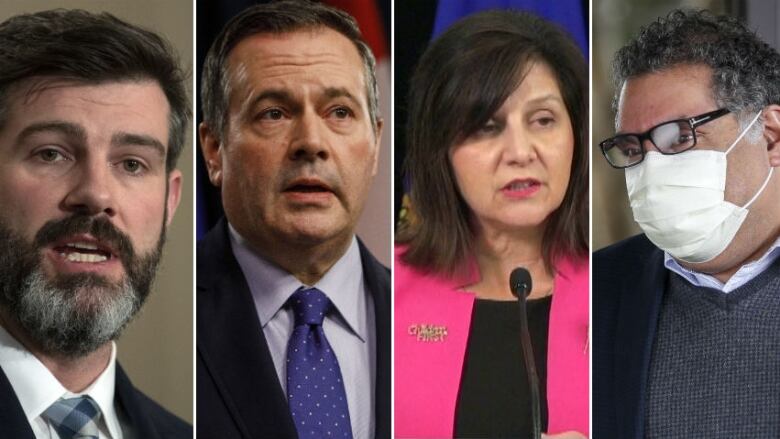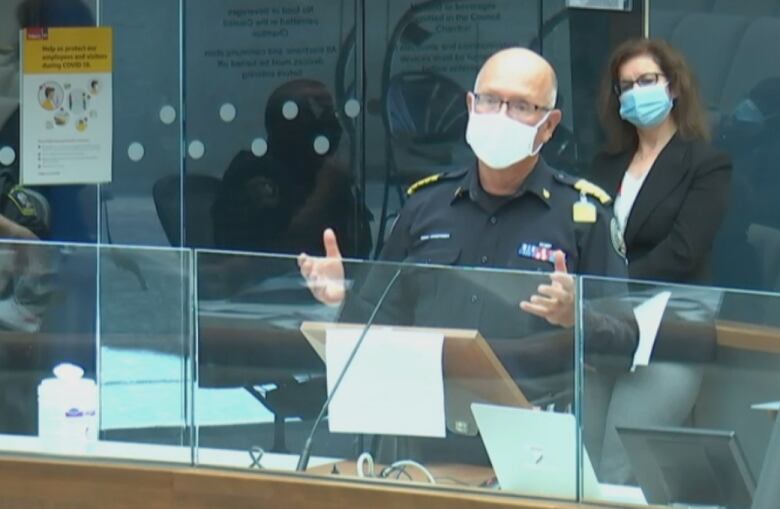Alberta's COVID-19 response is fragmenting as a 2nd wave looms
Top-down approach is changing as more responsibility shifts to municipalities, educators and individuals

It's been a bad couple of weeks for COVID-19 in Alberta.
From July 7 to 21, it recorded the most new cases, per capita, of all provinces, according to federally compiled data.
Alberta also saw the highest percentage of positive tests over that time,and now has the highest per-capita rate of active cases in Canada. Its hospitalization rate is on the rise and secondonly to Quebec.
Alberta has five broad health zones and, for the first time in the pandemic, significant numbers of new cases have been cropping up in all five at the same time.
The largest surge is in the Calgary zone, where physicians have been makingimpassioned pleasfor more government action to limit the spread, and city council suddenly opted to require face coverings in indoor, public places. Edmonton's council is set to consider a similar bylaw at an emergency advisory committee meeting on Thursday.
With all this going on at the municipal level, it was striking to see provincial leaders strike a less dire tone this week.
At a press conference Tuesday, Premier Jason Kenney said "we should all be very concerned about the recent rise in active COVID-19 cases" while simultaneouslyannouncing plans for a"near-normal" return to classes in September. No class-size limits. No mandatory masks.
Even Kenney's warning came with an asterisk. He chided Albertans who had been ignoring public health orders to "knock it off," before softening the rebuke by adding:"We're not expecting perfection ... let's just do our best."
The disparate tone at the provincial and municipal levelshighlights the challenge in steering a province-wide response to this disease, when infection rates in localareas can turn on a dime. It also signals the growing amount of responsibility the province is looking to offload onto educators, municipal leaders and everyday Albertans to manage future flare-ups of this novel virus.
Like the one Alberta is experiencing now.
From girding to reassuring
Over the course of the pandemic, the province's official messaging has drifted from girding Albertans for a coming storm to reassuring them that it's safe to go outside again as long you're careful.
There were just 60 active cases back on March 15, when the province announced in-school classes would be cancelled indefinitely, a measure that seemed extreme to many Albertans at the time.
There were 694 active cases on April 7,when Kenney convened a special televised address and warned the public that the pandemic was "perhaps the greatest challenge of our generation." He made a point of speaking directly to those Albertans who "wonder if we're overreacting to all of this" and assured them the economic lockdown he had ordered was necessary.
The foreboding tone has waned recently, even as the active caseload has grown.
There were 1,193 active cases on Tuesday, when the province announced the return to classes.
Premier Kenney and Education Minister Adriana LaGrange tried to reassure nervous parents and teachers, citing studies that suggest children are less prone to both infection and transmission of the disease(while not mentioning a recent study that suggests otherwise) and emphasizing safety measures like staggered lunch breaks and new pick-up and drop-off protocols at schools.
Still, they acknowledged that new infections are inevitable.
"We anticipate that there will be some cases in schools," LaGrange said. "But again, we have a very strong plan in place, so that when there is a case, we will be able to identify it quickly. We will be able to contain it."
Chief Medical Officer of Health Dr. Deena Hinshaw said some degree of spread among kids and teachers was preferable to the alternative, because "extended school closures negatively impact children's overall long-term mental, emotional and physical health."
School boards expressed concerns about where the money will come from for classroom retrofits, additional cleaning supplies and hand sanitizer. The president of the AlbertaTeachers' Association said he can't picture how the province's vision for a safe return to classrooms will work in schools with thousands of students.
Parents who don't feel comfortable should reach outto their local schools, LaGrange said, asthe province is only providing the "broad strokes" of how to mitigate the risk, while the "fine details are left to the school divisions to implement."
This decentralized approach extends beyond just schools.
Municipal governments and masks
Calgary city council has been known for lengthy deliberations that ultimately end with difficult decisions being deferred to a later date, but this week it acted with unusual haste.
It began with a proposed bylaw for mandatory masks on Calgary Transit and took things a step furtherrequiring face coverings in all indoor public places (with a few exceptions) as of Aug. 1.
"Absent of anybody else taking action, I think what we're saying is we need to take some action," Tom Sampson, chief of the Calgary Emergency Management Agency, told council during the debate whilewearing a maskhimself.

Coun. Ward Sutherland expressed some hesitation about whether the municipal government was overstepping its bounds, saying he would "prefer that maybe the province stepped in and did this," but ultimately voted in favour of the bylaw.
"Our numbers are way above when we shut everything down," he said of the current COVID-19 caseload."So, just using that comparison, I have no issues supporting this. I understand the people that want freedom but I also look at the data. It's not good."
As Edmonton mulls a mask bylaw, Mayor Don Iveson has said enforcing such rules would be difficult for the city and called on the Alberta government to make face coverings in public a requirement on a provincial level.
Calgary's mask bylaw, which passed by a 12-3 vote, was quickly applauded by physicians and business leaders. But some questioned why it doesn't extend to schools.
Calgary Mayor Naheed Nenshi said that may come next, if the province doesn't change its own policy.
"We need a better plan from the Government of Alberta," he said. "And if we don't have one, you know, the City of Calgary, we have to maintain people's safety and if we have to step into the fray, we will."
Colin Aitchison, the education minister's press secretary, said in an email Wednesday that "municipalities have the authority to enact bylaws for their communities" butthe province is standing by itsdecision, based on the latest advice from Dr. Hinshaw.
We were all in this together
Another bit of advice from Hinshaw bordering on a mantra has been that "we are all in this together."
But, for the first time in this pandemic, Albertans are seeing significant disagreement between their leaders on how best to respond to a looming second wave.
After bringing the hammer down once, forcing schools and businesses to close en masse, the provincial government is reluctant to do it again.
"The last thing we want to do is impose damaging restrictions on our economy and our freedoms," Kenney said.
Instead, it is leaving the subsequent dance with the disease to municipalities, school boards and the collective behaviour of individual Albertans.
The province is betting this decentralized approach will be the best course forward, as it tries to walk atightrope, balancing a complex set of risks to health, the economy and society at large.
But if things go wrong, Alberta may have no choice but to bring the hammer back.












_(720p).jpg)


 OFFICIAL HD MUSIC VIDEO.jpg)
.jpg)



























































































